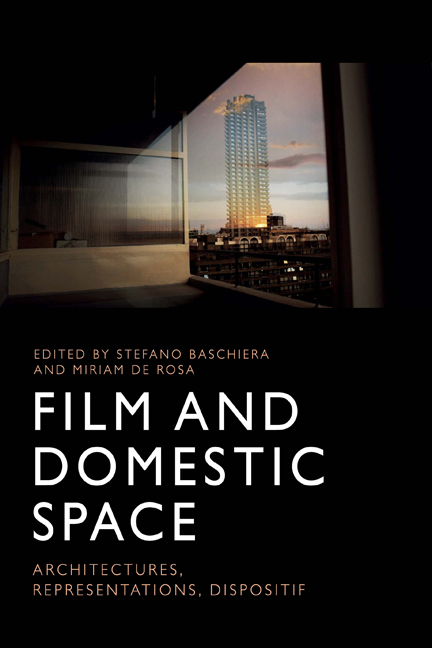Book contents
- Frontmatter
- Contents
- List of Figures
- Notes on the Contributors
- Acknowledgements
- Introduction
- 1 Architectures of Ubiquity: The Colonial Revival in Film and Television
- 2 No Down Payment: Whiteness, Japanese American Masculinity and Architectural Space in the Cinematic Suburbs
- 3 Resist, Redefine, Appropriate: Negotiating the Domestic Space in Contemporary Female Biopics
- 4 Liminal Spaces, Lesbian Desire and Veering off Course in Todd Haynes’s Carol
- 5 A Home on the Road in Claire Denis’s Vendredi soir
- 6 Acoustic Ectoplasm and the Loss of Home
- 7 Our House Now: Flat and Reversible Home Spaces in Post-war Film and Television
- 8 From Myth to Reality: Images of Domestic Space in Post-Soviet Baltic Films
- 9 No | Home | Movie: Essay Film, Architecture as Framing and the Non-house
- 10 At Home with the Nouvelle Vague: Apartment Plots and Domestic Urbanism in Godard’s Une femme est une femme and Varda’s Cléo de 5 à 7
- 11 Dwelling the Open: Amos Gitai and the Home of Cinema
- 12 What Is Cult When It’s At Home? Reframing Cult Cinema in Relation to Domestic Space
- 13 High-fructose Cinema and the Movie Industrial Complex: Radicalising the Technology of Representation in a Domestic Kind of Way
- Index
6 - Acoustic Ectoplasm and the Loss of Home
Published online by Cambridge University Press: 22 September 2020
- Frontmatter
- Contents
- List of Figures
- Notes on the Contributors
- Acknowledgements
- Introduction
- 1 Architectures of Ubiquity: The Colonial Revival in Film and Television
- 2 No Down Payment: Whiteness, Japanese American Masculinity and Architectural Space in the Cinematic Suburbs
- 3 Resist, Redefine, Appropriate: Negotiating the Domestic Space in Contemporary Female Biopics
- 4 Liminal Spaces, Lesbian Desire and Veering off Course in Todd Haynes’s Carol
- 5 A Home on the Road in Claire Denis’s Vendredi soir
- 6 Acoustic Ectoplasm and the Loss of Home
- 7 Our House Now: Flat and Reversible Home Spaces in Post-war Film and Television
- 8 From Myth to Reality: Images of Domestic Space in Post-Soviet Baltic Films
- 9 No | Home | Movie: Essay Film, Architecture as Framing and the Non-house
- 10 At Home with the Nouvelle Vague: Apartment Plots and Domestic Urbanism in Godard’s Une femme est une femme and Varda’s Cléo de 5 à 7
- 11 Dwelling the Open: Amos Gitai and the Home of Cinema
- 12 What Is Cult When It’s At Home? Reframing Cult Cinema in Relation to Domestic Space
- 13 High-fructose Cinema and the Movie Industrial Complex: Radicalising the Technology of Representation in a Domestic Kind of Way
- Index
Summary
Between 1969 and 1972 the British composer Gavin Bryars put pen to paper and composed a piece of music called The Sinking of the Titanic. In this minimalist piece, Bryars acknowledged something that the horror genre has been engaging with for decades; namely, that sounds never die. They mutate, transform and move as sound waves lengthen, but they do not disappear. Unlike images, they do not require a copy to prevent their absence. In The Sinking of the Titanic, Bryars imagines the musicians of the infamous vessel playing as the ship sinks: the sounds shifting and warping as water and distance, both temporal and spatial, alter the sound waves; the music becoming a memory, an echo of a past time, which is doomed to forever repeat itself. The sounds become artefacts and a tangible connection to the past. They are an ectoplasm that exteriorises what the source has left behind once it has faded. There is nothing static about sounds; whether in their creation or transmission, sounds require movement. This movement has the possibility of either transporting us to another time, or rooting us to a specific location. We are so accustomed to sounds, which accompany us throughout both life's mundane and its momentous events, that we sometimes forget to listen. Careful consideration of a soundscape, whether real or imagined, can, as Kendall Wrightson (2000: 10) states, allow us to be ‘transported to another time, another place’.
Every location will have its own unique shape and sound, waiting to be heard. This sense of sonic entrapment, of sounds waiting and caught in an endless utterance, is a key motif within a certain subsection of the horror genre, specifically those that deal with haunted houses. How do spaces so familiar to us, containing sounds so commonly heard, become so alien and hostile? In this chapter I want to explore how the sounds of the horror genre both shape and respond to common notions of domesticity and associated discourses on the home. Here we have a genre that plays on core beliefs of safety and ownership, but which highlights the transitory nature of ‘home’.
- Type
- Chapter
- Information
- Film and Domestic SpaceArchitectures, Representations, Dispositif, pp. 106 - 117Publisher: Edinburgh University PressPrint publication year: 2020



